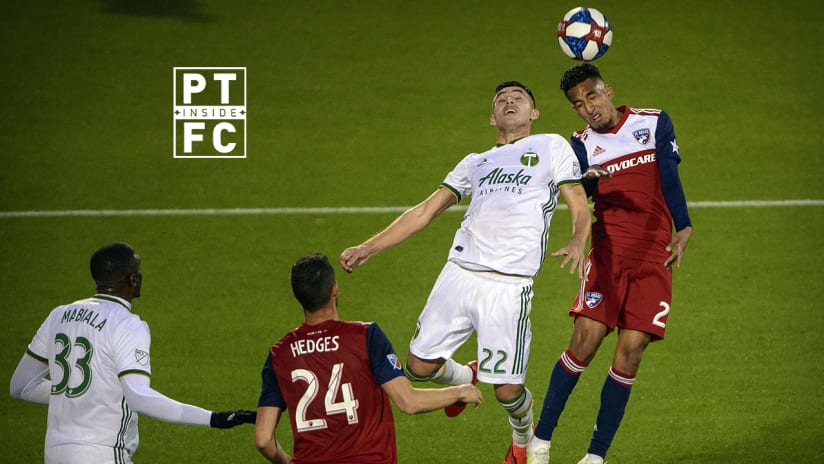Going into halftime on Saturday at Toyota Park, Portland Timbers head coach Giovanni Savarese alluded to something that may have been overlooked, with four or five clear FC Dallas chances providing the major talking points from the match’s first 45 minutes. Savarese, though, offered a concern that addressed another part of his team’s play – the way his side was executing going toward the other team’s goal.
“We just have to be a little bit cleaner with the ball,” he told sideline reporter Nat Borchers, on the field at Toyota Stadium. “The field is moving the ball a little too fast, and we’re not finding the right passes. But once we find the right combinations, we’re going to be dangerous.”
No moment captured Savarese’s thought better the one below. Last season, the Timbers became known in some circles as a counterattacking team – an unfairly reductive assessment, but one that captured how others saw the team’s greatest threat. Let players like Diego Valeri,Sebastián Blanco, Samuel Armenteros and Diego Chara loose in the open field, and you’re headed for a bad result.
This year, though, too many counterattacks are looking like this one, from the 22nd minute in Frisco, Texas:
One definition of technical proficiency on the soccer field is being able to do simple things with speed, something that involves more than your on-the-ball technique. It requires precise application, vision, anticipation, as well as effort. You have able to see, process, react and exert. Without those things, proficiency remains theory, not applied.
The clip, above, is a little unfair, as it picks one of the first half most glaring examples and, merely be examining it, implies that sequence is the norm. It’s not, but it’s still helpful in illustrating what Savarese was talking about.
After the ball is played from Portland’s 18-yard box, there’s a brief opportunity to a create a five-on-two break. Blanco is high, off camera, with four other Timbers players rushing to him.

Dallas only has two players back (one off camera). But play slows before the first pass, then slows again as Portland not only overplays the ball but doesn’t lead each other into space. At no point is the first wave of attackers able to reach full speed. Passes go to where players are, not where they’re going to (and should) be.
There’s also a recognition element, here, that is important. Blanco goes wide right and stays high, giving Chara and Jorge Moreira a potentially defense-cracking option. A pass is going to travel faster than players run, and if a ball is played early into the space deep on the right flank, the Timbers will have a chance to sprint into the space Dallas’ defense, having to spread to cover the pass’s width, leaves in the penalty box. Blanco might be rushed as defenders adjust, but when he plays the ball back across, the Timbers will be vastly outnumbering their markers.
Unfortunately, when the pass is played late, Dallas has had time to recover. The best Portland can do is earn a deep throw-in.
Things like this happen all the time, throughout games, whether teams are struggling or excelling. At the highest levels, they may happen less frequently, but you still see players pass the ball to the wrong foot or not lead teammates into space, or away from pressure. Picking out one moment and dissecting it is less of an indictment of the moment than just the reality of soccer. Could the sequence, above, have been better? Of course. But in soccer, most sequences could be better. That’s part of the reason why there are so few goals.
Still, it’s important to note where play can be cleaner. For example, in the 20th minute, Chara let a pass rolled to him run into space, even though but that space was being occupied by a Dallas player. FCD forced a turnover just outside their attacking third. In the 35th minute, rough touches by Andrés Flores and Moreira slowed play while the Timbers were in their attacking shape. The team had to settle for a speculative shot from Zarek Valentin. In the 42nd minute, Blanco recovered nicely from a touch which, having got away from him, halted a passing progression, while a minute later, a pass toward the penalty area from Flores to Cristhian Paredes was played to head, not to feet. In each of these cases, nothing bad resulted from the missteps, but with each pause, correction, or adjustment that has to be made, the Timbers lose the momentum they were trying to build.
When all those touches are clean, though? Well, it doesn’t always look like this (below), but two weeks ago against the LA Galaxy, Timbers fans saw the benefit of being precise with your touches.
From the very moment Moreira plays back to Julio Cascante, look at the precision. Chara’s touch into space, in front of him, to keep Zlatan Ibrahimovic at bay? On a wet field in Frisco, those touches ended up being popped up, stalling play, allowing defenders to challenge the ball. As we saw in Carson, California, though, when teams can play with precision, speed, and confidence, beautiful soccer is possible.
Fast forward to Saturday’s second half, and we have this, below. Nobody will hold it up as being a paragon of technical excellence, but from Chara laying a switch onto Blanco’s laces, to Blanco, attacking the area, hitting Paredes in stride, the Timbers’ technical quality allowed them to act on their instincts.
The storm in Dallas made that difficult, but in the second half, a small bit of that quality returned. And over the last half-hour-plus, the Timbers were able to play with confidence. Teams are always going to have stretches where their technical proficiency is lacking, but when coaches like Savarese say their teams need to be cleaner with their touches, this is what they’re talking about.












